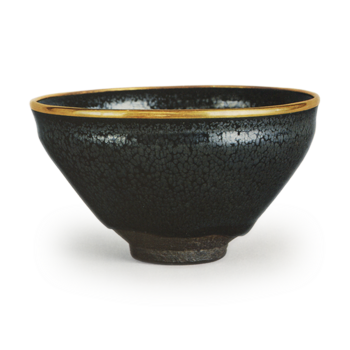

major landmarks
National Treasure
Height: 6.8-7.0 cm
Mouth diameter: 12.3 cm
Outer diameter of stand: 4.3 cm
Height: 0.7 cm
In one of the “Kimidai Kanjo Joki”, it is written, “Aburidotsu, the next of yohen, is not inferior to yohhen”.
The shape of the bowl is a typical kenrishiki, with the mouth firmly twisted back, the base is low, and the inside of the base is shallowly flattened and gouged out to form a snake’s eye shape. The inside and outside are covered with black glaze, and numerous silver oil droplets appear on the glaze. The glaze is cut off at the outer rim, and the rest of the piece is exposed.
The clay in the exposed area is a rather coarse clay with a high iron content, which is hard-fired and has a blackish grayish color. Under the rim of the mouth, the glaze has thinned and turned reddish, and there are fine oil droplets scattered on it. A thick glaze pool is formed at the edge of the glaze at the waist, where oil droplets are running down and forming a jasme-like appearance. The under edge of the glaze drip has several areas of joint repair, which may indicate that the glaze drip was polished at some point in time.
The oil droplets appear in a tight formation both inside and outside, with little space between them, and the black glaze outlining the droplets is often left as a few thin lines. The droplets are clinging to each other, forming an irregular shape, and the thin lines outlining the droplets appear to be a kind of mysterious pattern. The silvery oil droplets have a slight bluish tint to them, creating an attractive body. The inner surface is particularly beautiful, with a rainbow-like band of wisteria-purple to pale blue-blue color in the middle of the droplet, giving it a unique and noble flavor.
The mouth rim is covered with a gold band.
This is the most famous tea bowl among all the Yudorikitenmoku ware, and is thought to have been fired around the 13th century at the Jian Kiln in Fujian Province, China. It is not clear when it came to Japan, but it is thought that it probably came to Japan around the end of the Kamakura period or early Muromachi period.
It was originally owned by Sekihaku Hidetsugu and considered one of the tools of the Juraku clan, but later moved to Nishi Honganji Temple and then to the Mitsui family in Rokkaku, Kyoto. Later, it entered the possession of the Sakai family, the lords of the Wakasa domain, where it has remained to this day. It was designated as a new national treasure in 1953.
It is furnished with a white double-layered cover, a black lacquered hikikiya with a lock, two replacement covers, and three tenmokudai (a stand with a tenmoku stand). One of them is a vermilion lacquer chrysanthemum-shaped tenmoku-dai, which belonged to Kobori Enshu and was attached to the Mitsui family when it was in their possession. The other two are called Wakasa-tendai, made of inner vermilion and outer blue lacquer, and one of them is said to have belonged to Ryoji Arima.



